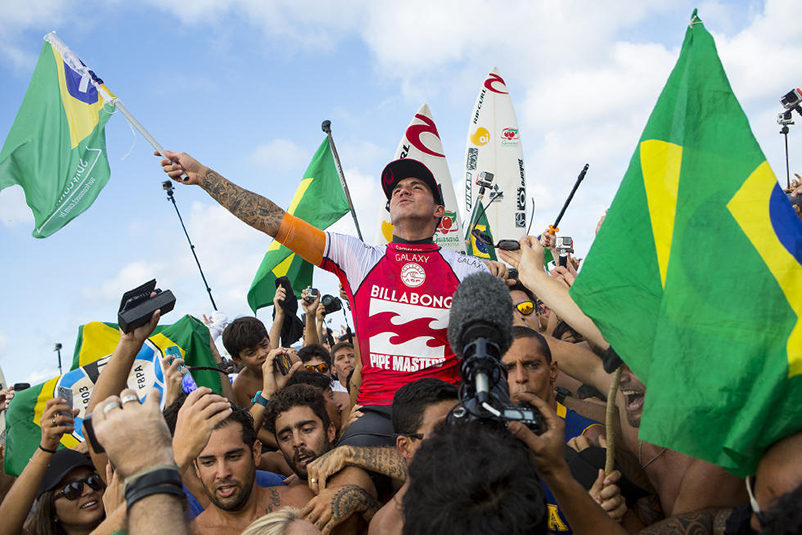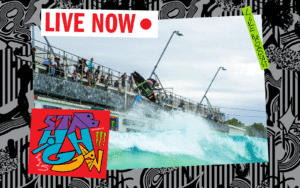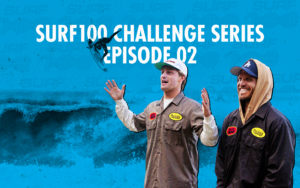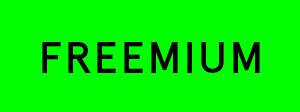Separation of Church and State
Story by Craig Jarvis It wasn’t that long ago that digital took hold and surf photographers had to reinvent themselves to deal with a rapidly changing world. A world that saw their digital imagery, once on the Internet, being taken and used, with nary a cent being handed over, and with little way to control it all. Some of them pulled it off, while many others didn’t make it and started building websites and renovating houses while their lenses gathered dust. “We had to learn to adapt to an ever-changing environment,” says photographer Alan Van Gysen, one of the success stories through the transition. “Staying relevant was the key.” This was made that much harder when the WSL took over their first event in Australia, the Quiksilver Pro Gold Coast 2014. Yet this initial hard line drawn by the WSL on independent photographers, who had to sign all imagery rights over to the WSL in return for a media pass, seems to have softened, almost organically of late. Essentially, when it comes to professional surfing, does the world really need too much independent media any more? If anyone needs high resolution, high action photos from a day’s worth of Championship Tour competition they need look no further than the most go-to surfing website in the world right now, WSL. There they can find Kirstin Scholtz and Kelly Cestari’s images available, for free. Good quality imagery, with land and water angles and shot on smart equipment. Sharp, neatly colour corrected and mostly free with a click. There’s no longer a need for magazines to fly a photographer across the world, unless you have the sort of budget that needs to be spent unnecessarily. The WSL imagery handouts are good. Kirstin Schultz in the eye of the Brazilian storm. Photo: WSL/Kirstin Schultz… obviously. With regards to video coverage, there is a plethora of WSP-produced YouTube video links available for your website, also just a click away. Some are published minutes after they happen live. Why send down a videography team to do the same work, most likely with inferior production values? Want some highlights for a local TV station of your local Championship Tour surfer? Well, the WSL provide this as well. Geo-targeted, and timeous, to make the evening news deadlines the world over. No need to send a TV news crew. Then when it comes to the journalists, the friendly bottom feeders that we are, we’re the most unnecessary. There are daily global press releases, there are daily local press releases, and there are social media updates throughout the day going to a massive global audience. The scores are all known instantaneously through the Webcast or through a Tweet/Instagram/Facebook update, and if anyone needed to dig a bit further then it’s a quick click on the heat analyzer link to relook a 10-point ride or the validity of an interference call. WSL’s VP of Communication Dave Prodan insists that this control of WSL media assets was not meant to alienate independent media. “The primary focus of controlling theWSL media assets, such as the broadcast, was to invest in a consistently high-quality product that could be accessed in a singular location – www.worldsurfleague.com,” says Prodan. “Before this a surf fan would have to go to 10 different websites to view 10 different events, with varying production qualities and inconsistent commentary” At the J-Bay Open, prior to the biggest story in surfing’s history it was a different story however. The media center was subdued. At the contest site the only people interviewing surfers and getting quotes were the WSL teams. Pete, Todd or Rosy would get a few questions in, then a WSL video crew would do the same. There was no one shoving iPhones into surfers’ faces post heats. While doing a short interview for Surfline, even Kelly Slater mentioned that no one had been asking him for interviews this year. Therewas no need to – the WSL editorial team had already extracted all that was necessary from the 11 times world champion The question is, will the WSL continue to embrace independent media at their events even though the need is no longer that great? “Absolutely. There must exist a church and state’ separation when it comes to the League and the media that cover it,” reckons Prodan. ”Surfing, as a community, thrives on authenticity. You cannot script surfing.” Yet with such a highly efficient editorial team producing free, high quality media, will there actually be a need for independents to cover events in the future? As explained here – their online audience keeps climbing, while it seems that on the ground the independent media participation continues to dwindle. Will the WSL’s mainstream traction alienate surf media? Prodan doesn’t think so. “The advantage of an independent media group covering surfing is that they’re afforded an editorial voice that the league, being 100% objective, is not,” says Prodan. “I think there are still engaging stories that have yet to be told – really digging into who these athletes are that compete at surfing’s highest level, the continued evolution of surfboard design for high-performance surfing, the rich histories of the venues and the stories that make them up, etc. There’s a lot of reporting that’s yet to be done.’ The Gonzo angle – that of sex and drugs and rock n roll –used to often find its way into the independent angle, when the surfers were a bit looser and less focused. These days the combination of a more athletic approach, possible drug testing, possible media litigation and the threat of advertisers pulling spend from surf media if any of their pro team members are disgraced, means that no one dares to publish the fact that their B-grade journalist enjoyed tequila shots off a young waitress’s hairless vulva with a former world champ these days. It no longer happens. This was probably the last such story published: Moral Panic at The J-Bay Pro on Acid. It is still possible to come up with a
Story by Craig Jarvis
It wasn’t that long ago that digital took hold and surf photographers had to reinvent themselves to deal with a rapidly changing world. A world that saw their digital imagery, once on the Internet, being taken and used, with nary a cent being handed over, and with little way to control it all.
Some of them pulled it off, while many others didn’t make it and started building websites and renovating houses while their lenses gathered dust. “We had to learn to adapt to an ever-changing environment,” says photographer Alan Van Gysen, one of the success stories through the transition. “Staying relevant was the key.”
This was made that much harder when the WSL took over their first event in Australia, the Quiksilver Pro Gold Coast 2014. Yet this initial hard line drawn by the WSL on independent photographers, who had to sign all imagery rights over to the WSL in return for a media pass, seems to have softened, almost organically of late. Essentially, when it comes to professional surfing, does the world really need too much independent media any more?
If anyone needs high resolution, high action photos from a day’s worth of Championship Tour competition they need look no further than the most go-to surfing website in the world right now, WSL. There they can find Kirstin Scholtz and Kelly Cestari’s images available, for free. Good quality imagery, with land and water angles and shot on smart equipment. Sharp, neatly colour corrected and mostly free with a click. There’s no longer a need for magazines to fly a photographer across the world, unless you have the sort of budget that needs to be spent unnecessarily. The WSL imagery handouts are good.

Kirstin Schultz in the eye of the Brazilian storm. Photo: WSL/Kirstin Schultz… obviously.
With regards to video coverage, there is a plethora of WSP-produced YouTube video links available for your website, also just a click away. Some are published minutes after they happen live. Why send down a videography team to do the same work, most likely with inferior production values? Want some highlights for a local TV station of your local Championship Tour surfer? Well, the WSL provide this as well. Geo-targeted, and timeous, to make the evening news deadlines the world over. No need to send a TV news crew.
Then when it comes to the journalists, the friendly bottom feeders that we are, we’re the most unnecessary. There are daily global press releases, there are daily local press releases, and there are social media updates throughout the day going to a massive global audience. The scores are all known instantaneously through the Webcast or through a Tweet/Instagram/Facebook update, and if anyone needed to dig a bit further then it’s a quick click on the heat analyzer link to relook a 10-point ride or the validity of an interference call. WSL’s VP of Communication Dave Prodan insists that this control of WSL media assets was not meant to alienate independent media. “The primary focus of controlling theWSL media assets, such as the broadcast, was to invest in a consistently high-quality product that could be accessed in a singular location – www.worldsurfleague.com,” says Prodan. “Before this a surf fan would have to go to 10 different websites to view 10 different events, with varying production qualities and inconsistent commentary”
At the J-Bay Open, prior to the biggest story in surfing’s history it was a different story however. The media center was subdued. At the contest site the only people interviewing surfers and getting quotes were the WSL teams. Pete, Todd or Rosy would get a few questions in, then a WSL video crew would do the same. There was no one shoving iPhones into surfers’ faces post heats. While doing a short interview for Surfline, even Kelly Slater mentioned that no one had been asking him for interviews this year. Therewas no need to – the WSL editorial team had already extracted all that was necessary from the 11 times world champion
The question is, will the WSL continue to embrace independent media at their events even though the need is no longer that great? “Absolutely. There must exist a church and state’ separation when it comes to the League and the media that cover it,” reckons Prodan. ”Surfing, as a community, thrives on authenticity. You cannot script surfing.” Yet with such a highly efficient editorial team producing free, high quality media, will there actually be a need for independents to cover events in the future? As explained here – their online audience keeps climbing, while it seems that on the ground the independent media participation continues to dwindle. Will the WSL’s mainstream traction alienate surf media? Prodan doesn’t think so. “The advantage of an independent media group covering surfing is that they’re afforded an editorial voice that the league, being 100% objective, is not,” says Prodan. “I think there are still engaging stories that have yet to be told – really digging into who these athletes are that compete at surfing’s highest level, the continued evolution of surfboard design for high-performance surfing, the rich histories of the venues and the stories that make them up, etc. There’s a lot of reporting that’s yet to be done.’
The Gonzo angle – that of sex and drugs and rock n roll –used to often find its way into the independent angle, when the surfers were a bit looser and less focused. These days the combination of a more athletic approach, possible drug testing, possible media litigation and the threat of advertisers pulling spend from surf media if any of their pro team members are disgraced, means that no one dares to publish the fact that their B-grade journalist enjoyed tequila shots off a young waitress’s hairless vulva with a former world champ these days. It no longer happens. This was probably the last such story published: Moral Panic at The J-Bay Pro on Acid.
It is still possible to come up with a different angle however. One that isn’t covered by the WSL and one that doesn’t include a local charity photo-shoot, or a game park drive, which are the common feel-good back-stories. One can write a piece on how the gig of a surf journalist is approaching possible redundancy, and try and get that story published.














Comments
Comments are a Stab Premium feature. Gotta join to talk shop.
Already a member? Sign In
Want to join? Sign Up